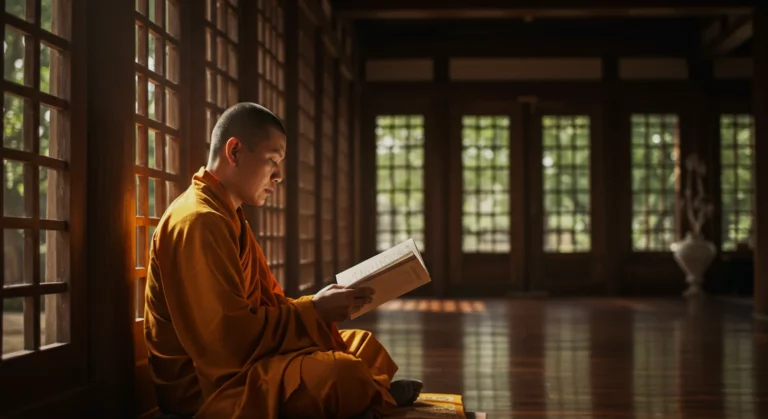If you’d like to learn more about what sutras are, one of the best ways to do so is by taking a look at one of the most famous sutras in the world: the Heart Sutra.
A better understanding of the Heart Sutra has the potential to radically shift your perspective. It could seriously change your life.
Why? Because, as Deborah King, Author of Mindvalley’s Be A Modern Master Program, explains, “The sutra practice is compelling and forceful. You have no idea where it could take you.”
The Heart Sutra is special. There’s a reason it’s one of the most popular sutras in Mahayana Buddhism.
The Heart Sutra communicates one of the most essential philosophical teachings on Earth—and unlocking its deeper meaning could totally change the way you see the world.

What Is the Heart Sutra In Buddhism?
The Heart Sutra is one of the most popular sutras in Mahayana Buddhism. It belongs to a larger collection of sutras that were composed between 100 – 500 BCE.
In Sanskrit, it’s called Prajñāpāramitāhṛdaya, which means, “The Heart of the Perfection of Wisdom.” It represents the pure distillation of wisdom, or prajna.
So, what makes the Heart Sutra so compelling? Its simplicity.
The entire sutra is only a page long, and its language is straightforward and to the point.
But the teaching itself? It’s complicated. No, really. This one’s a real head-scratcher.
In fact, some scholars have gone so far as to call the Heart Sutra a complete paradox.
At first glance, it looks simple enough. But the teaching the Heart Sutra attempts to communicate is complex.
That’s why unlocking the truth of the Heart Sutra could literally change your life.
It doesn’t just change the way you see the world. It actually shifts the vibration of your consciousness.
Coming to know the Heart Sutra is coming to know a deep truth of our living reality.
What does Prajnaparamita mean?
Prajnaparamita is the Sanskrit title for the Heart Sutra.
It’s a combination of two Sanskrit words – prajñā “wisdom” with pāramitā “perfection.”
In Buddhism, Prajnaparamita means “the perfection of wisdom.” It tells us about the perfect way to perceive reality.

What Does the Heart Sutra Actually Say?
The Heart Sutra is a written record of a conversation that took place between Avalokiteshvara Bodhisattva, one of the most revered bodhisattvas, or spiritual teachers, in the Buddhist tradition, and a disciple of the Buddha, Shariputra.
In it, Avalokiteshvara attempts to explain to Shariputra that all things are expressions of emptiness. The ultimate truth of our existence is that nothing is truly distinct. Everything exists as a part of everything else. Essentially: we’re all interconnected.
Here are some of the most powerful passages from the Heart Sutra. Read each slowly and carefully. Give them some time to sink in.
“Form does not differ from emptiness, emptiness does not differ from form. That which is form is emptiness, that which is emptiness is form.”
“Shariputra, all dharmas are marked with emptiness; they do not appear or disappear, are not tainted or pure, do not increase or decrease.”
“No ignorance and also no extinction of it, and so forth until no old age and death and also no extinction of them. No suffering, no origination, no stopping, no path, no cognition, also no attainment with nothing to attain.”
Pretty powerful stuff, huh? You can also take a look at the full translation of the Heart Sutra in English if you’d like to explore it yourself.
What does ‘Gate Gate Paragate Parasamgate Bodhi Svaha’ mean?
This is the mantra we hear the end of Heart Sutra.
The whole mantra, translated into English, means: “Oh awakening that has gone, gone, gone to the further shore, gone completely to the further shore. Amen.”

How to Apply the Wisdom of the Heart Sutra to Your Life
The Heart Sutra explores one of the fundamental concepts of Buddhism: emptiness. But this is an emptiness in a way you might not have considered before.
The emptiness described in the Heart Sutra isn’t emptiness in the traditional sense of an empty glass or an empty room.
Emptiness, or in Sanskrit, shunyata, is the concept of perceiving events, objects, and ideas without coloring them with the tint of our perception.
It’s a lot like mindfulness in that way, actually.
Both emptiness and mindfulness encourage us to separate ourselves from our stories. We tell ourselves stories about who we are and how we feel and why we do what we do. We attach to our stories because they give form our identity – ego, the “I”, separating us from the rest of the world.
The Heart Sutra communicates that separateness is actually an illusion. And the individual identities we assign and are assigned are also an illusion.
It’s a tough concept that challenges the way you view yourself and others. But it’s definitely one worth considering.
Explore the Heart Sutra on your own and see what you make of it. Print it out and stick it on your wall. Incorporate it into your meditation practice. Listen to it while you practice yoga.
You might be surprised by the impact it has on your day-to-day life.







